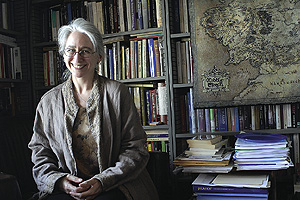Rachel Fulton, Associate Professor in History and the College
By William HarmsNews Office
 Rachel Fulton (Photo by Beth Rooney) | |
Rachel Fulton likes to inspire her students to ask great questions as they explore the role of fact and fantasy in the Middle Ages.
“I’ve learned to teach by teaching at Chicago,” said Fulton, Associate Professor in History and the College, who joined the faculty in 1994.
“The style of teaching I use is one that works in this community. In order to teach, I have to show students how to ask questions.
“I usually don’t do straight lectures, but engage students in discussions to get them engaged in the texts,” she explained. “But when I do lecture, I do it from the perspective of asking what the problems are at hand. I want them to be able to learn how to ask good questions and then be prepared to give them answers that satisfy that curiosity.”
Students bring to her classes an interest in the Middle Ages, often based on stories of chivalry, such as the Arthurian legends, or ideas derived from films or fantasy stories.
“What I want them to realize is that during the Middle Ages, the knights were sometimes acting out their roles, such as when they took part in tournaments. I show them pictures of armor, for instance, and ask them to determine if the armor is real and intended for battle, or if it is merely decorative,” she said.
Her classes for undergraduate students cover a range of topics in the Middle Ages and include the courses, “History of European Civilization,” “Tolkien: Medieval and Modern,” “Knights and Samurai” (co-taught with Susan Burns, Associate Professor in History and the College), “Medieval Travelers,” and “War in the Middle Ages.”
“I’ve enjoyed teaching here because students are willing to take risks. They’re intellectually so curious and imaginatively so capable,” she said. She organizes her assignments accordingly.
“I often have students write papers in which they take on a character from the period and write from that person’s perspective. It’s a way of taking ownership of the topic but also encourages them to do the research they need to understand the time, as well as the biases and perspectives the people of that period may have had. It’s totally different from writing a paper from an abstract, distant perspective,” she said.
In the class on author J.R.R. Tolkien, Fulton lets students write stories based on fantasy as well as academic papers, because Tolkien did both as he worked through issues of his deep Catholic faith and his calling as an academic.
Fulton’s own interest in the Middle Ages began in high school in Amarillo, Texas, when she had an English and humanities teacher who inspired her enthusiasm and also took his students on a summer trip to Europe. “I remember seeing the cathedrals and becoming excited about the Middle Ages,” she said.
“That teacher, Gary Biggers, was my favorite teacher, and in many ways I try to teach the way he did. He really worked to engage the students in the subject we were studying. We read Dante’s Inferno and had to choose a sinner and determine which circle of Hell that person would end up in,” she said.
“But he also taught us to see history as the big picture. We learned how religion was related to society,” for instance.
From high school, Fulton went on to Rice University, where she earned a B.A. in history and religious studies in 1986.
She studied at Cambridge University from 1986 to 1988, and then went on to Columbia University, where she received an M.Phil. in history in 1990 and a Ph.D. in 1994.
She has published extensively on topics related to the Middle Ages and is the author of From Judgment to Passion: Devotion to Christ and the Virgin Mary, 800-1200.
![[Chronicle]](/images/sidebar_header_oct06.gif)